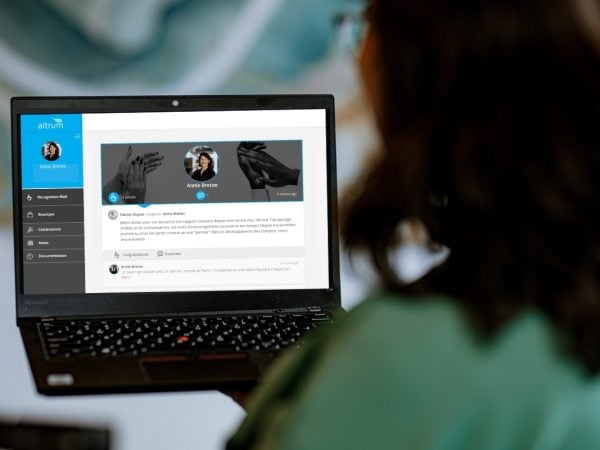The Generational Recognition Gap: Why Personalization is Key
April 7, 2025, In Employee Engagement
Recognition at work isn’t just about handing out the occasional gift card or sending a “great job!” email. It’s about making employees feel seen, valued, and motivated to keep doing their best. But here’s the catch – what feels meaningful to one person might completely miss the mark for another.
Think of recognition like a birthday gift. You wouldn’t give your best friend something generic and impersonal, right? The same goes for appreciating employees. A one-size-fits-all approach just doesn’t cut it anymore.
Why Generic Recognition Fails

Picture this: You buy a “one-size-fits-all” sweater for your entire team. Some find it too tight, others too loose, and a few don’t even like the style. That’s exactly how employees feel when recognition isn’t tailored to their preferences – it’s awkward, ineffective, and sometimes even demotivating.
Sure, monetary rewards are great. But here’s the thing: Employees want more than just an occasional bonus or an impersonal gift. They want to feel genuinely valued. Some might love extra time off, while others prefer redeemable points they can use for something they actually want. And let’s not forget non-monetary recognition – because no one sticks around just for a company-branded mug every five years.
Employees stay when they feel seen. When their achievements are noticed, when they get meaningful feedback, and when they have a clear path for growth. In fact, according to a Gallup study, companies with strong recognition programs see a 31% lower voluntary turnover rate – because employees don’t leave companies where they feel valued.
But here’s where it gets tricky: different generations want recognition in different ways. While Gen Z thrives on public shoutouts, Millennials might prefer something more low-key but still meaningful. Gen X and Boomers? They tend to appreciate more formal, milestone-driven recognition.
How Each Generation Defines Recognition

So, what does recognition look like across generations? Let’s break it down:
Gen Z (Born 1997–2012)
- Craves instant feedback and digital recognition – think social media shoutouts, team kudos, or public praise during meetings.
- Prefers experiences over things – personal growth opportunities, mentorship, and career development matter most.
- Loves gamification – rewards systems where they can accumulate points and redeem them for things they actually want.
Millennials (Born 1981–1996)
- Value meaningful work – recognition should tie back to their contributions and impact.
- Appreciate flexible rewards – extra time off, skill-building opportunities, or wellness perks.
- Like a mix of private and public recognition – some love LinkedIn shoutouts, others prefer a simple “thank you” from their manager.
Gen X (Born 1965–1980)
- Independent and pragmatic – they appreciate straightforward, sincere recognition.
- Prefer private acknowledgments (a well-written email or 1:1 praise over a flashy public post).
- Value work-life balance rewards, like extra PTO or the ability to work remotely.
Baby Boomers (Born 1946–1964)
- Prefer formal, milestone-driven recognition – think plaques, certificates, and service awards.
- Appreciate recognition that highlights their loyalty and expertise rather than just their latest achievement.
- Tend to like private recognition over social media-style shoutouts.
The Role of Technology in Personalizing Recognition

Tech isn’t just for Gen Z – when used right, it can make recognition meaningful for everyone. Here’s how:
- Recognition platforms: A digital space where manager and employees can send shoutouts, keeping engagement high across all generations.
- Customizable rewards systems: Let employees pick what matters most to them (gift cards, experiences, donations, or points to accumulate).
- Peer recognition walls: Like a company-wide LinkedIn, but internal – great for Millennials and Gen Z who love public recognition.
- Automated milestone celebrations: Never miss a birthday or work anniversary again – especially for Gen X and Boomers who value tenure recognition.
- Virtual appreciation letters: A heartfelt, personalized email from leadership that makes employees feel truly seen (this works across all generations).
Building a Multi-Generational Recognition Strategy

If you want to get recognition right, here’s what to do:
- Survey your employees: Ask them how they like to be recognized. It’s that simple.
- Offer flexible recognition options – Not everyone wants a Starbucks gift card. Give them choices.
- Train your managers: Help them understand the differences in recognition preferences across generations.
- Encourage a culture of recognition: Don’t just leave it up to leadership. Encourage peer-to-peer appreciation, too.
Actionable Steps for Leaders

If you’re a leader, here’s your roadmap:
- Audit your current recognition programs – Are they working for all generations? If not, what’s missing?
- Involve employees – Let them help shape recognition initiatives so they actually resonate.
- Leverage technology – Use tools that make recognition easy, timely, and personalized.
- Train managers regularly – Help them understand the evolving needs of a multi-generational workforce.
- Monitor and adjust – Keep collecting feedback and adapting your approach.
Final Thoughts

At the end of the day, recognition isn’t about following a checklist – it’s about making people feel valued in a way that actually matters to them. When companies get this right, employees are happier, more engaged, and more likely to stick around.
So, whether it’s a LinkedIn shoutout, a handwritten note, or an extra day off – what truly counts is making recognition personal. Because when people feel seen, they show up, and they stay.










